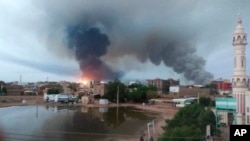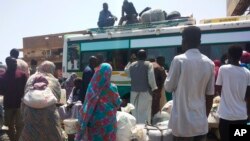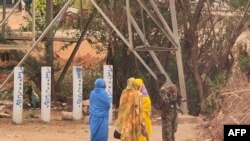Whether Sudan’s warring parties stick to the latest U.S.-Saudi Arabian-brokered cease-fire agreement remains an open question. What is not in doubt is that Saturday’s 24-hour truce has capped another murderous week of intense fighting in which civilians were the main victims.
Since fighting between Sudan’s army and the paramilitary Rapid Support Forces erupted April 15, Sudan’s Federal Ministry of Health says nearly 800 people have been killed and 5,800 wounded.
The U.N. refugee agency said Friday 1.42 million people have become internally displaced and nearly half a million have crossed borders as refugees.
This past week alone, fighting between Sudan’s rival factions in and around the capital, Khartoum, has taken a heavy toll on civilian lives. Attacks against a busy livestock market, residential areas and a refugee center reportedly killed dozens of people.
While people are dying from shelling and gunfire, the lack of humanitarian aid and a rapidly deteriorating human rights situation are compounding their misery.
Jeremy Laurence, UNHCR spokesman, said Friday his office has received concerning reports of conflict-related sexual violence.
“Since the fighting began, our office has received credible reports of 12 incidents of sexual violence related to the conflict against at least 37 women—although the number could be far higher.
“In at least three incidents, the victims were young girls. In one case, 18 to 20 women were reportedly raped.”
Laurence said growing reports of apparent enforced disappearance and arbitrary detention were another cause for concern. He said that journalists were at heightened risk “amid a rise in online hate speech and disinformation.”
“Our office has learnt of a list circulating on social media accusing certain journalists of being supporters of the RSF. We have observed comments on Facebook calling for the killing of the journalists on the list,” he said.
Alfonso Verdu Perez, the outgoing head of delegation for the International Committee of the Red Cross in Khartoum, said Friday he was present when the conflict began in mid-April and since has witnessed the heavy toll combat and violence have taken on the civilian infrastructure of the densely populated city.
“Electricity and water levels have been severely damaged. We fear outbreaks of diseases because many residents have had no choice but to use unsafe drinking water from the river, from the Nile and other sources. At the same time, food and fuel prices have skyrocketed and the situation has been made worse for many people by the fact that they cannot even access their money in their banks.”
Perez said the situation in Darfur was equally worrying. He said robberies and looting were on the rise, power stations and markets have been looted. He said more than 200 people reportedly were killed in the town of El Geneina in western Darfur in just a few days early last month.
He warned that this flare-up of violence could easily escalate and worsen the already dire humanitarian situation in the region.
“Health care may collapse at any moment, despite the best efforts of Sudanese doctors and nurses who have continued working in extremely difficult conditions caring for the wounded and providing other essential health care services to communities.”
The Red Cross official said conditions in Khartoum were no better, saying that only an estimated 20% of the city’s health facilities were still functioning. Those facilities, he said, were facing severe shortages of water, power, food, and essential medical supplies were running low.




















